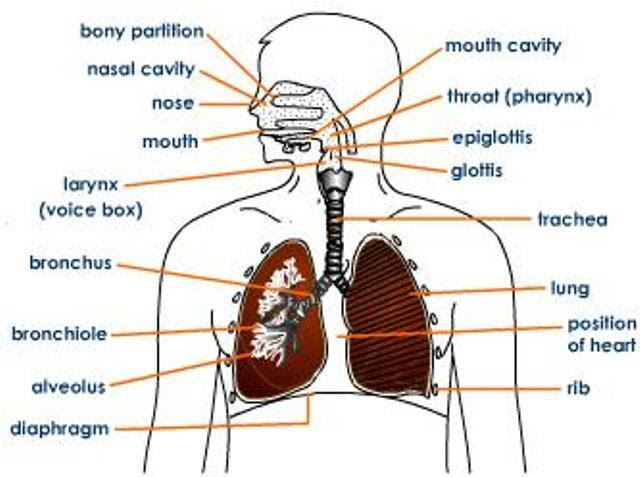
Respiratory surface of animals must always be moist. Why?
Answer
379.5k+ views
Hint: Exchange of gases occurs in both plants and animals. For such exchange to occur, animals have a respiratory system which is made up of particular organs which performs tasks specific to the process of respiration.
Complete answer:
Gas exchange takes place on the respiratory surface which usually includes the gills, trachea, lungs, etc. Alveoli and alveolar blood capillaries lead to the exchange of gases in the lungs.
Image showing respiratory system

During the process of breathing in animals, which is termed as aerobic respiration, an exchange of gaseous components is conducted where the carbon dioxide leaves the cell and oxygen enters the system. By diffusing gases over their cell membrane, single-celled organisms can diffuse gas directly across their cell membrane.
But by diffusing gas across the outer surface, large animals are unable to sustain their gas exchange. Thin, moist epithelial cells cover the respiratory surface, which allows oxygen and carbon dioxide to get exchanged. Therefore, respiratory surfaces must be wet for these gases to cross cell membranes.
Note:
Humans and other living beings benefit from the respiratory system, which consists of a network of organs and tissues that let them breathe.
A human body's airways, lungs, and blood arteries are part of this system as shown in the image above. The respiratory system also includes the lungs' muscles. These components work together to transport oxygen throughout the body and remove waste gases such as carbon dioxide from the bloodstream.
Complete answer:
Gas exchange takes place on the respiratory surface which usually includes the gills, trachea, lungs, etc. Alveoli and alveolar blood capillaries lead to the exchange of gases in the lungs.
Image showing respiratory system

During the process of breathing in animals, which is termed as aerobic respiration, an exchange of gaseous components is conducted where the carbon dioxide leaves the cell and oxygen enters the system. By diffusing gases over their cell membrane, single-celled organisms can diffuse gas directly across their cell membrane.
But by diffusing gas across the outer surface, large animals are unable to sustain their gas exchange. Thin, moist epithelial cells cover the respiratory surface, which allows oxygen and carbon dioxide to get exchanged. Therefore, respiratory surfaces must be wet for these gases to cross cell membranes.
Note:
Humans and other living beings benefit from the respiratory system, which consists of a network of organs and tissues that let them breathe.
A human body's airways, lungs, and blood arteries are part of this system as shown in the image above. The respiratory system also includes the lungs' muscles. These components work together to transport oxygen throughout the body and remove waste gases such as carbon dioxide from the bloodstream.
Recently Updated Pages
The correct geometry and hybridization for XeF4 are class 11 chemistry CBSE

Water softening by Clarks process uses ACalcium bicarbonate class 11 chemistry CBSE

With reference to graphite and diamond which of the class 11 chemistry CBSE

A certain household has consumed 250 units of energy class 11 physics CBSE

The lightest metal known is A beryllium B lithium C class 11 chemistry CBSE

What is the formula mass of the iodine molecule class 11 chemistry CBSE

Trending doubts
State the laws of reflection of light

One Metric ton is equal to kg A 10000 B 1000 C 100 class 11 physics CBSE

Difference Between Prokaryotic Cells and Eukaryotic Cells

How do I convert ms to kmh Give an example class 11 physics CBSE

Describe the effects of the Second World War class 11 social science CBSE

Which of the following methods is suitable for preventing class 11 chemistry CBSE




